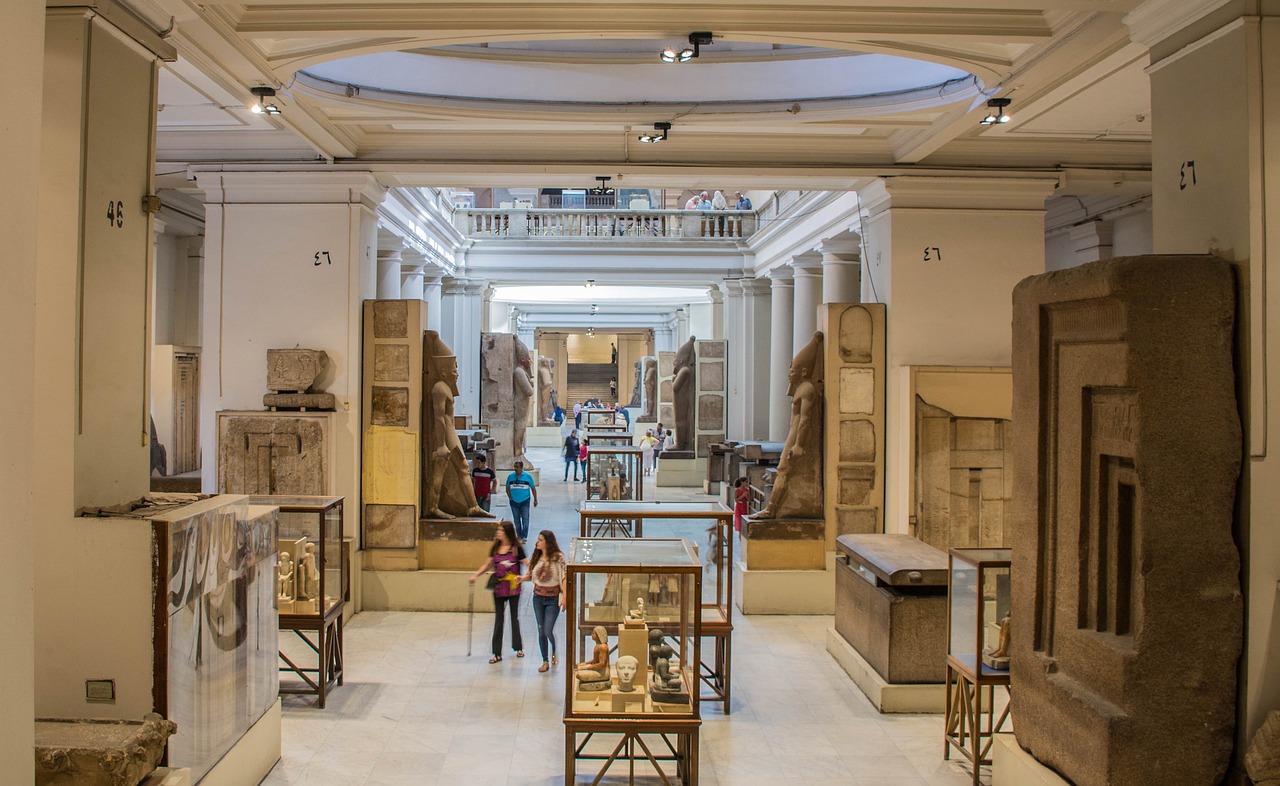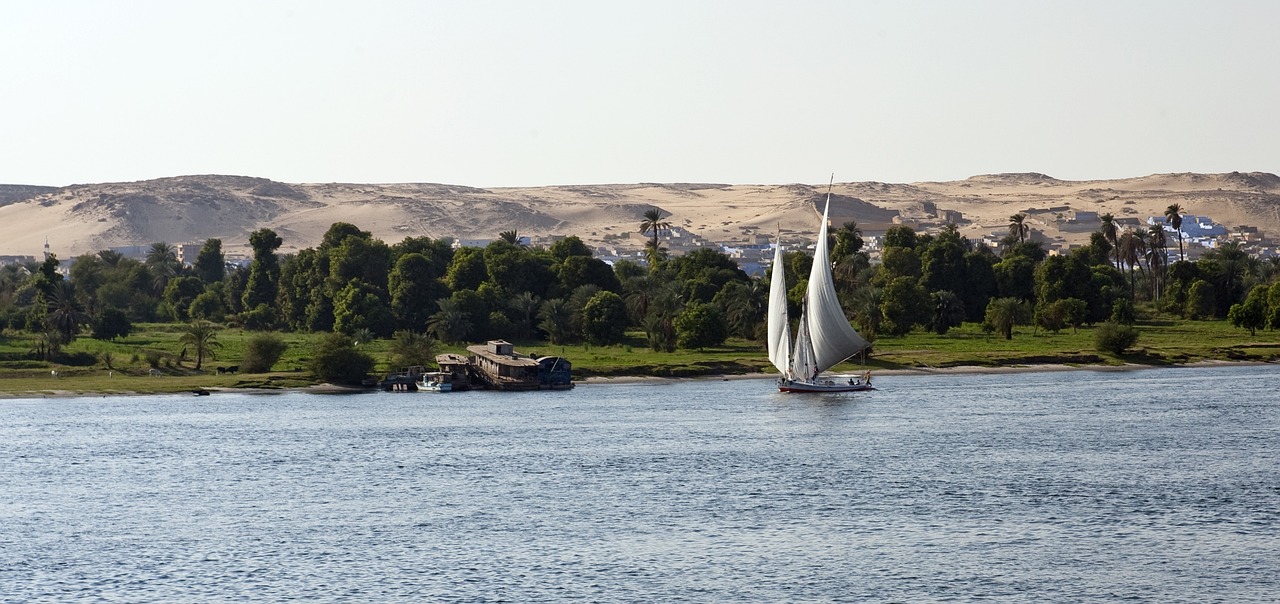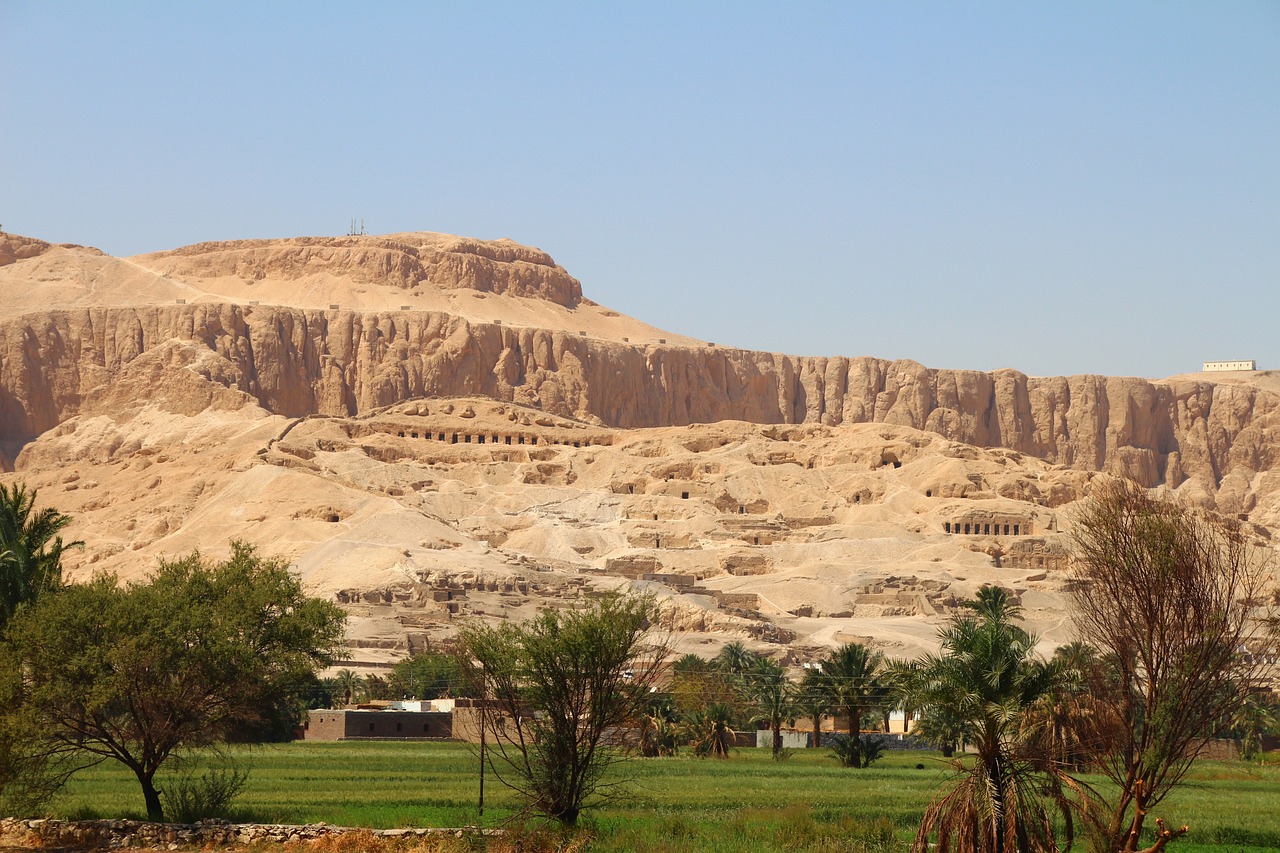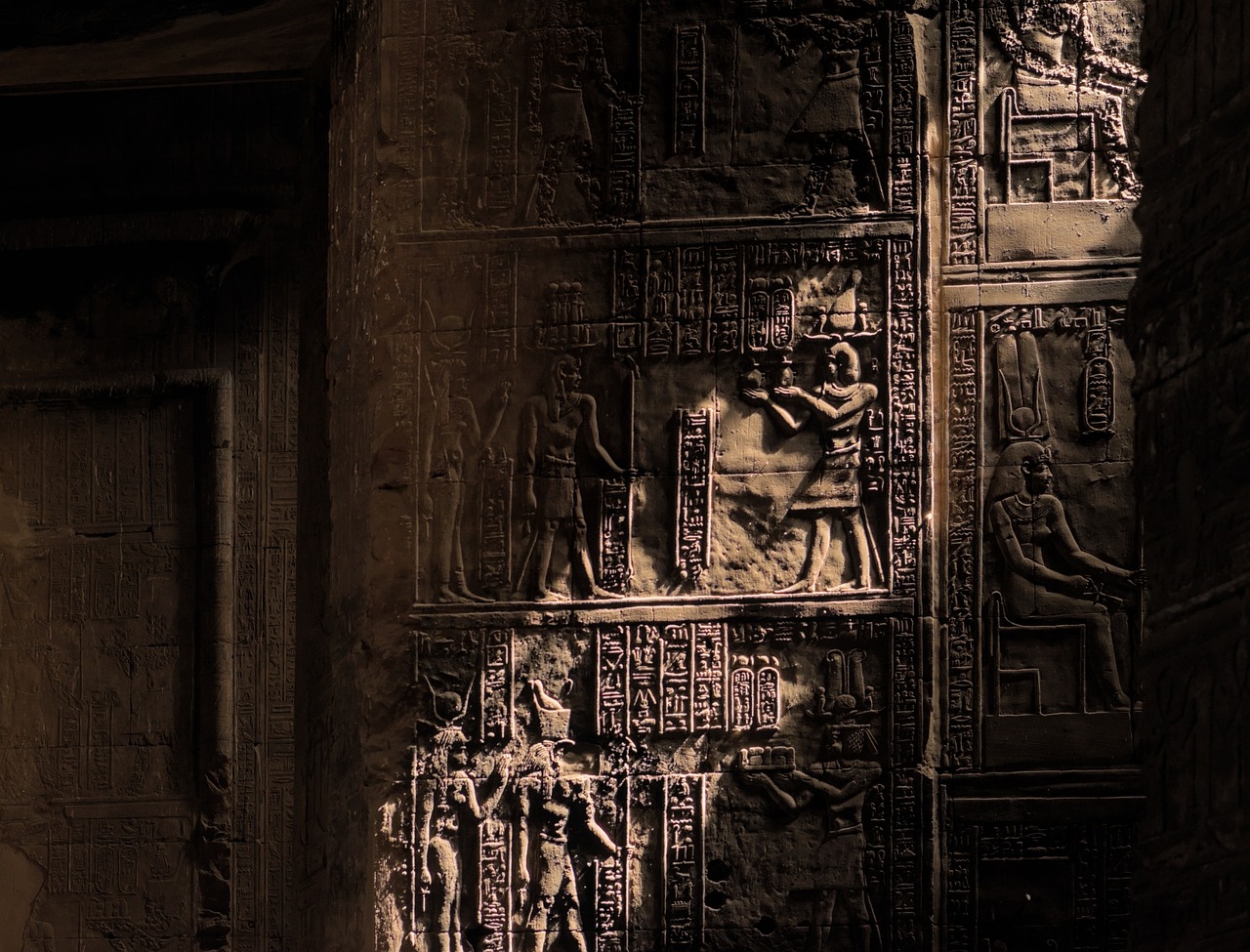The Secrets of Ancient Egyptian Economic Systems
Exploring the fascinating economic structures and practices of ancient Egypt reveals a complex web of trade, agriculture, taxation, labor systems, and currency use that sustained one of history's most enduring civilizations. The ancient Egyptians were not only skilled builders of monumental pyramids but also astute architects of economic systems that supported their society's growth and prosperity.
Trade Networks and Commerce played a pivotal role in the economic landscape of ancient Egypt. The civilization's extensive trade routes and partnerships connected it to neighboring regions, facilitating the exchange of goods such as papyrus, gold, and grain. These trade networks not only enriched the Egyptian economy but also fostered cultural exchange and diplomatic ties with other civilizations.
Delving into Agricultural Practices and Irrigation unveils the innovative farming techniques that allowed the ancient Egyptians to harness the fertile lands of the Nile River. Their sophisticated irrigation systems ensured consistent agricultural abundance, leading to prosperity and stability within the society. The ability to control and utilize the Nile's waters was a cornerstone of their economic success.
Taxation and Tribute were essential components of the ancient Egyptian economic system. The government employed various methods to collect taxes and tribute from the populace, using these resources to fund public projects, maintain infrastructure, and support the ruling elite. Taxation was not only a means of revenue generation but also a tool for social control and wealth distribution.
The Labor Force and Workforce of ancient Egypt were diverse and specialized. Skilled artisans, craftsmen, farmers, and builders all contributed to the economy through their hard work and expertise. The labor force was organized hierarchically, with individuals fulfilling specific roles based on their skills and social status. This division of labor was crucial for the functioning of the economy.
Unraveling the complexities of Currency and Barter Systems in ancient Egypt sheds light on the various mediums of exchange used in transactions. Commodities like grain and metal served as forms of currency, alongside barter systems that facilitated trade. The sophisticated economic transactions of the ancient Egyptians demonstrate their advanced understanding of commerce and value exchange.
Wealth Disparities and Social Classes were prominent features of ancient Egyptian society. From the affluent nobility and priests to the common laborers and slaves, there existed a clear hierarchy in wealth distribution. The economic system reinforced social stratification, with wealth and status closely intertwined. This disparity in wealth played a significant role in shaping social dynamics and power structures.
Marketplaces and Economic Centers were vibrant hubs of activity in ancient Egypt. Merchants, traders, and consumers converged in bustling marketplaces to engage in commercial activities and transactions. These economic centers were not only places of trade but also social gathering spots where ideas, goods, and cultures intermingled, enriching the economic landscape of the civilization.
Reflecting on the Legacy of Economic Practices of ancient Egypt highlights the enduring influence of their economic systems on subsequent civilizations. The resilience and adaptability of these age-old economic principles have left a lasting impact on the development of economic structures worldwide. The legacy of ancient Egyptian economic practices serves as a testament to the sophistication and ingenuity of one of history's greatest civilizations.

Trade Networks and Commerce
Exploring the fascinating economic structures and practices of ancient Egypt, shedding light on their trade, agriculture, taxation, labor systems, and currency use that sustained one of history's most enduring civilizations.
Trade was the lifeblood of ancient Egypt, with bustling marketplaces and extensive trade networks that connected the civilization to distant lands. The Egyptians engaged in commerce not only within their borders but also with neighboring regions, establishing lucrative partnerships that facilitated the exchange of a variety of goods. Papyrus, a material vital for writing and record-keeping, was a highly sought-after commodity, along with precious metals like gold and essential grains.
These trade routes not only brought in valuable resources but also fostered cultural exchange and diplomatic ties with other civilizations. The Nile River served as a vital artery for transportation, allowing merchants to navigate the waters and transport their goods efficiently. The bustling trade activities in ancient Egypt were a testament to the civilization's economic prowess and strategic positioning in the ancient world.
Moreover, the commerce of ancient Egypt was not limited to goods alone; it also involved the exchange of ideas, technologies, and innovations. The vibrant trade networks played a crucial role in shaping the economic landscape of the region, fueling growth and prosperity for the ancient Egyptians.
Q: How did ancient Egyptians conduct trade with other civilizations?
A: Ancient Egyptians engaged in trade through established trade routes that connected them to neighboring regions. They exchanged goods like papyrus, gold, and grain, fostering economic growth and cultural exchange.
Q: What role did the Nile River play in the trade networks of ancient Egypt?
A: The Nile River served as a vital transportation route for merchants, allowing them to navigate the waters and transport goods efficiently. It facilitated trade activities and contributed to the economic prosperity of ancient Egypt.
Q: How did trade contribute to the economic development of ancient Egypt?
A: Trade brought in valuable resources, fostered cultural exchange, and facilitated the transfer of technologies and innovations. It played a significant role in shaping the economic landscape of ancient Egypt, fueling growth and prosperity for the civilization.

Agricultural Practices and Irrigation
The agricultural practices of ancient Egypt were deeply intertwined with the Nile River, which served as the lifeblood of the civilization. The annual flooding of the Nile deposited nutrient-rich silt on the riverbanks, creating fertile soil ideal for agriculture. To harness this natural advantage, the ancient Egyptians developed sophisticated irrigation systems that allowed them to control the flow of water to their fields.
One of the most remarkable irrigation techniques utilized by the ancient Egyptians was the shaduf, a simple yet effective device used for lifting water from the river and onto the fields. Consisting of a long pole with a bucket at one end and a counterweight at the other, the shaduf enabled farmers to irrigate their crops efficiently. Additionally, the ancient Egyptians constructed canals and dikes to divert water from the Nile to different areas, ensuring a steady water supply for their agricultural endeavors.
The cultivation of crops played a vital role in the economy of ancient Egypt, with staples such as wheat, barley, and flax being grown extensively. The ancient Egyptians practiced crop rotation to maintain soil fertility and maximize yields, demonstrating a sophisticated understanding of agricultural principles. Moreover, they also cultivated fruits like figs, dates, and pomegranates, showcasing the diversity of their agricultural output.
Furthermore, the ancient Egyptians engaged in animal husbandry, rearing cattle, sheep, and goats for meat, milk, and wool. The abundance of livestock not only provided sustenance for the population but also served as a source of labor for agricultural tasks such as plowing and transportation. The integration of livestock into agricultural practices underscored the holistic approach of the ancient Egyptians towards farming.

Taxation and Tribute
Exploring the fascinating economic structures and practices of ancient Egypt, shedding light on their trade, agriculture, taxation, labor systems, and currency use that sustained one of history's most enduring civilizations.
Within the intricate web of the ancient Egyptian economic system, taxation and tribute played crucial roles in funding the empire's operations and sustaining its grandeur. The collection of taxes was a meticulous process overseen by government officials who ensured that each citizen contributed their fair share to the state's coffers. Tribute, on the other hand, often came in the form of goods or services offered by vassal states or conquered territories as a sign of submission and allegiance.
Imagine the bustling markets of Thebes or Memphis, where traders bartered goods under the watchful eye of tax collectors, ensuring that no transaction escaped the reach of the state's revenue system. The wealth amassed through taxation and tribute fueled the construction of monumental structures like the pyramids and temples, showcasing the economic prowess of ancient Egypt.
Moreover, the taxation system was not limited to monetary contributions but extended to goods produced by farmers, craftsmen, and artisans. Grain, livestock, and other commodities were subject to taxation, with a portion allocated to the state for public projects and the maintenance of infrastructure. This system of wealth redistribution ensured a semblance of social equity while also consolidating the pharaoh's power and influence.
While the burden of taxation may have been felt by the common laborers and farmers, it also symbolized their contribution to the greater good of Egyptian society. Through their toil and tributes, they upheld the economic foundation upon which the empire thrived, sustaining a civilization that continues to captivate and inspire us to this day.
- Q: How were taxes collected in ancient Egypt?
- A: Taxes in ancient Egypt were collected through various means, including in-kind contributions such as grain and livestock, as well as monetary payments. Tax collectors oversaw the process and ensured compliance from all segments of society.
- Q: What was the purpose of tribute in ancient Egypt?
- A: Tribute in ancient Egypt served as a form of acknowledgment and submission from vassal states or conquered territories. It often included valuable goods or services offered to the pharaoh as a sign of loyalty and allegiance.
- Q: Did all social classes in ancient Egypt pay taxes?
- A: Yes, taxes were levied on all social classes in ancient Egypt, although the amount and type of taxation varied based on one's wealth and occupation. Even farmers and laborers contributed a portion of their produce or earnings to the state.

Labor Force and Workforce
In ancient Egypt, the labor force and workforce were integral components of the economy, encompassing a diverse array of skilled individuals who contributed to the prosperity of the civilization. From the skilled artisans who crafted intricate jewelry and ornate artifacts to the farmers who toiled in the fields to ensure a bountiful harvest, each member of the labor force played a crucial role in sustaining the economic engine of ancient Egypt. The workforce also included builders who constructed monumental structures like the pyramids and temples, showcasing their expertise and dedication to their craft. Moreover, laborers engaged in various tasks such as quarrying stone, transporting goods along the Nile, and maintaining the infrastructure essential for the functioning of society.
One of the remarkable aspects of the labor force in ancient Egypt was the specialization of skills among different groups of workers. Artisans honed their craft over years of apprenticeship, passing down their knowledge from generation to generation. Farmers utilized innovative agricultural techniques, such as the use of the shaduf for irrigation, to maximize crop yields and ensure food security for the population. Builders employed advanced engineering methods to erect monumental structures that stood the test of time, showcasing the ingenuity and expertise of ancient Egyptian craftsmen. The labor force was not only diverse but also highly organized, with individuals belonging to specific guilds or groups based on their skills and expertise.
Furthermore, the workforce in ancient Egypt was not limited to free citizens alone. Slaves and laborers from lower social classes also played a significant role in the economy, often working in construction projects or agricultural fields under the supervision of overseers. While the labor force was stratified based on social status, with skilled artisans enjoying higher prestige than manual laborers, each segment contributed to the overall functioning of society. The workforce's composition reflected the hierarchical structure of ancient Egyptian society, where individuals' roles and responsibilities were determined by their social standing and occupation.
The labor force and workforce of ancient Egypt exemplify the intricate web of economic activities that sustained one of the most advanced civilizations of the ancient world. Through their specialized skills, hard work, and dedication to their craft, individuals across various professions contributed to the flourishing economy of ancient Egypt. The legacy of the labor force and workforce endures as a testament to the ingenuity and resilience of the ancient Egyptians, whose economic systems laid the foundation for future civilizations to build upon and thrive.

Currency and Barter Systems
In ancient Egypt, the economic transactions were facilitated through a combination of currency and barter systems. While there was no standardized currency like we have today, commodities such as grain and metal served as mediums of exchange. The value of goods was determined based on their weight and quality, allowing for a system of trade that relied on the intrinsic value of the items being exchanged. Additionally, barter systems played a crucial role in transactions, especially in rural areas where direct exchange of goods and services took place without the need for a common currency.
Moreover, the use of **commodity money** was prevalent in ancient Egypt, where goods themselves were used as a form of currency. For example, grain was a common medium of exchange due to its widespread availability and importance in the Egyptian diet. Similarly, metals like gold and silver were also used for transactions, with their value determined by weight and purity. This system of commodity money allowed for flexibility in trade and transactions, as the value of goods could be easily assessed and exchanged.

Wealth Disparities and Social Classes
In ancient Egypt, the distribution of wealth was intricately tied to the social hierarchy, creating stark disparities between different classes of society. At the top of the pyramid were the affluent nobility and priests, who enjoyed immense wealth and power, often owning vast estates and controlling resources. They lived in opulent surroundings, adorned with luxuries that showcased their elevated status in society. These elite individuals wielded significant influence over economic decisions and political affairs, shaping the direction of the civilization.
Contrastingly, the common laborers and slaves occupied the lower rungs of the social ladder, facing economic hardships and limited opportunities for upward mobility. These individuals toiled in the fields, construction sites, and households, often under harsh conditions and with minimal compensation. Their labor was essential for sustaining the economy and supporting the privileged classes, yet they themselves struggled to break free from the cycle of poverty and servitude.
The economic disparities in ancient Egypt were not only evident in material wealth but also in access to education, healthcare, and legal rights. While the wealthy could afford the finest education for their children and access to advanced medical treatments, the lower classes often lacked these privileges, perpetuating a divide that reinforced social stratification. Moreover, the legal system favored the elite, providing them with greater protection and recourse in legal matters compared to the common people.
Despite these inequalities, the social classes in ancient Egypt were not entirely rigid, and individuals could sometimes move between strata through exceptional achievements or royal favor. Skilled artisans and craftsmen, for instance, could gain recognition and wealth through their talents, earning a higher social standing in the process. Additionally, individuals who distinguished themselves in military service or administrative roles could ascend the social hierarchy, attaining positions of authority and prestige within the society.
The wealth disparities and social classes in ancient Egypt underscored the complex dynamics of power, privilege, and opportunity that shaped the civilization. While the elite enjoyed prosperity and influence, the common people faced challenges and limitations that reflected the unequal distribution of resources and opportunities. By examining these disparities, we gain valuable insights into the economic and social structures of ancient Egypt, illuminating the intricacies of a society built on hierarchies and divisions.

Marketplaces and Economic Centers
Exploring the fascinating economic structures and practices of ancient Egypt, shedding light on their trade, agriculture, taxation, labor systems, and currency use that sustained one of history's most enduring civilizations.
Ancient Egypt was a vibrant hub of commercial activity, with bustling marketplaces and economic centers scattered across the land. These marketplaces served as vital meeting points where merchants, traders, and consumers converged to engage in a myriad of transactions.
The marketplaces of ancient Egypt were not just places of commerce but also social hubs where news was exchanged, relationships were forged, and cultural exchanges took place. Imagine the vibrant colors of exotic goods on display, the chatter of bargaining, and the aroma of various spices filling the air.
These economic centers were not only places for buying and selling goods but also served as crucial nodes in the intricate web of trade networks that connected Egypt to distant lands. Goods from as far as Mesopotamia, Nubia, and the Levant found their way to these bustling marketplaces, creating a rich tapestry of cultural exchange and economic prosperity.
Furthermore, these marketplaces were not limited to just physical goods but also facilitated the exchange of ideas, innovations, and technologies. It was here that new farming techniques, artisanal skills, and architectural designs were shared, contributing to the overall advancement of ancient Egyptian society.
Picture the scene: traders haggling over prices, artisans showcasing their finest creations, and farmers proudly displaying their bountiful harvests. The marketplaces of ancient Egypt were vibrant, dynamic spaces that encapsulated the essence of a thriving economy.
1. How did ancient Egyptians conduct trade with other civilizations?
2. What role did agriculture play in the economy of ancient Egypt?
3. Were there specific regulations governing marketplaces in ancient Egypt?
4. How did social classes impact economic opportunities in ancient Egyptian society?
5. What legacy did ancient Egyptian economic systems leave for future civilizations?

Legacy of Economic Practices
Exploring the fascinating economic structures and practices of ancient Egypt, shedding light on their trade, agriculture, taxation, labor systems, and currency use that sustained one of history's most enduring civilizations.
Ancient Egyptian economic practices have left an indelible mark on the world, influencing future societies and economic systems. The legacy of their innovative approaches to trade, agriculture, and wealth distribution continues to resonate through the annals of history.
One of the most enduring legacies of ancient Egyptian economic practices is their sophisticated trade networks and commerce strategies. The Egyptians' mastery of trade routes and partnerships set a precedent for international commerce, showcasing the importance of establishing connections with neighboring regions for mutual benefit.
Furthermore, the agricultural practices and irrigation systems developed by the ancient Egyptians have stood the test of time. Their innovative farming techniques not only ensured food security but also laid the foundation for sustainable agricultural practices that are still relevant today.
When it comes to taxation and tribute collection, the ancient Egyptians were pioneers in implementing systematic approaches to fund public projects and maintain infrastructure. Their methods of taxation served as a model for future governments seeking to finance public services through structured revenue collection.
The diverse labor force of ancient Egypt, ranging from skilled artisans to laborers, exemplified the importance of specialized skills and hard work in driving economic prosperity. This emphasis on a varied workforce highlighted the value of different professions and contributed to the overall economic growth of the civilization.
In terms of currency and barter systems, ancient Egypt's use of commodities like grain and metal as mediums of exchange laid the groundwork for modern monetary systems. Their barter practices also underscored the significance of fair trade and equitable transactions in fostering economic stability.
Despite wealth disparities and social classes, the ancient Egyptian economic system maintained a delicate balance between the elite and the common laborers. This hierarchical structure, while reflecting societal inequalities, also showcased the interdependence of different social strata in sustaining the economy.
The bustling marketplaces and economic centers of ancient Egypt served as vibrant hubs of commercial activity, where merchants, traders, and consumers converged to exchange goods and services. These marketplaces were not just places of trade but also centers of cultural exchange and social interaction, fostering economic growth and innovation.
Overall, the legacy of ancient Egyptian economic practices is a testament to the resilience and adaptability of their economic principles. By examining the economic systems of this ancient civilization, we gain valuable insights into the foundations of modern economics and the enduring impact of historical practices on contemporary society.
Frequently Asked Questions
- What were the main goods traded by ancient Egypt?
Ancient Egypt engaged in trade of various goods such as papyrus, gold, grain, linen, and precious stones. These commodities were highly sought after by neighboring regions and contributed significantly to Egypt's economic prosperity.
- How did the ancient Egyptians irrigate their crops?
The ancient Egyptians developed a sophisticated irrigation system centered around the Nile River. They utilized canals, dykes, and shadufs to control the water flow and ensure consistent watering of their fields, leading to bountiful harvests and agricultural success.
- What forms of currency were used in ancient Egypt?
Ancient Egypt primarily relied on a barter system where goods like grain, cattle, and metals were exchanged for other goods. However, they also used metal rings, known as deben, as a form of currency for larger transactions, showcasing the diverse nature of their economic practices.
- How did social classes impact the economy of ancient Egypt?
The social classes in ancient Egypt, ranging from pharaohs and nobility to peasants and slaves, played a crucial role in shaping the economy. Wealth disparities were evident, with the elite controlling resources and labor, while the lower classes supported the infrastructure and agricultural sectors through their work.
- What is the lasting influence of ancient Egyptian economic systems?
The economic systems of ancient Egypt left a lasting impact on subsequent civilizations by showcasing the importance of trade, agriculture, and organized labor. Their legacy can be seen in the development of currency, taxation, and market economies, highlighting the enduring relevance of their economic principles.



















